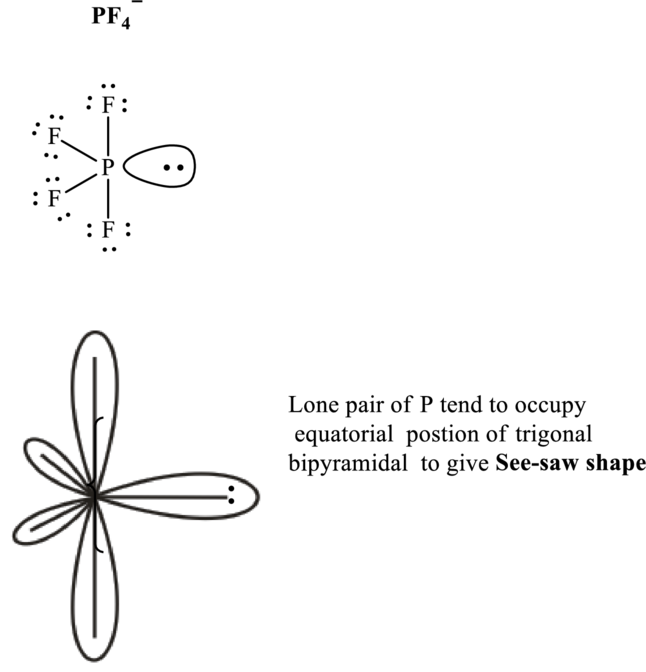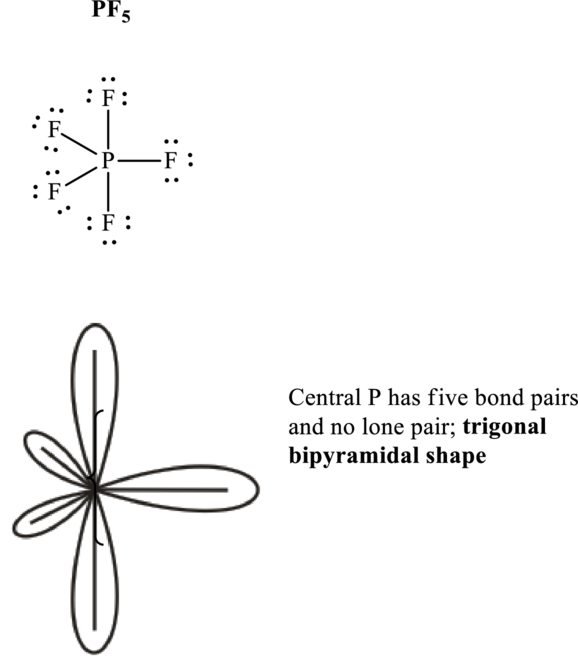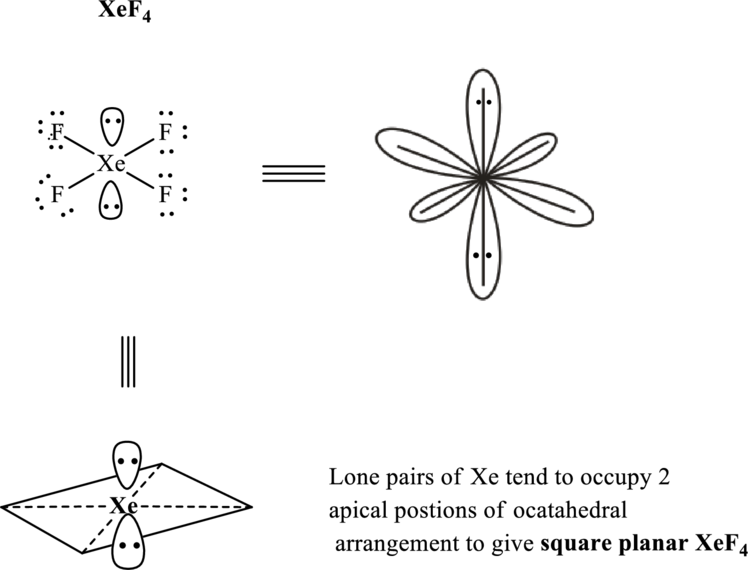
Concept explainers
(a)
Interpretation:
The VSEPR formula and shape for
Concept Introduction:
Valence Shell Electron Pair Repulsion model predicts shape by inclusion of bond angles and most distant arrangement of atoms that leads to minimum repulsion. For the molecules that have no lone pairs around the central atom the bonded-atom unshared -pair arrangement is decided by the table as follows:
In order to determine the shape the steps to be followed are indicated as follows:
- 1. Lewis structure of molecule should be written.
- 2. The type electron arrangement around the central atom should be identified around the central atom. This essentially refers to determination of bond pairs and unshared or lone pairs around central atoms.
- 3. Then bonded-atom unshared -pair arrangement that can maximize the distance of electron pairs about central atom determines the shape.
For molecules that have lone pairs around central atom, lone pairs influence shape, because there are no atoms at the positions occupied by these lone pairs. The key rule that governs the molecular shape, in this case, is the extent of lone –lone pair repulsions are far greater than lone bond pair or bond pair-bond pair repulsions. The table that summarized the molecular shapes possible for various combinations of bonded and lone pairs are given as follows:
(a)
Answer to Problem 2E.12E
The shape for
Explanation of Solution
Total valence electrons are sum of the valence electrons on each atom along with uni-negative charge in
The skeleton structure in
These 13 electron pairs are assigned as lone pairs of each of the
Hence, the Lewis structure

If lone pairs are represented by E, central atom with A and other attached bon pairs by X, then for any see-saw species the VSEPR formula is predicted as
It is evident that in
(b)
Interpretation:
The VSEPR formula and shape for
Concept Introduction:
Refer to part (a).
(b)
Answer to Problem 2E.12E
The shape for
Explanation of Solution
Total valence electrons are sum of the valence electrons on each chlorine and central iodine in
The skeleton structure in
These 13 electron pairs are allotted as lone pairs of each of the chlorine atoms and central iodine to satisfy respective octets. Hence, the Lewis structure and corresponding VSPER geometry in

It is evident that in
Lone pairs tend to occupy the equatorial locations of trigonal plane in trigonal bi-pyramidal arrangement so as to have minimum repulsions in accordance with VSPER model. This results in see-saw shaped
(c)
Interpretation:
The VSEPR formula and shape for
Concept Introduction:
Refer to part (a).
(c)
Answer to Problem 2E.12E
The shape for
Explanation of Solution
Total valence electrons are sum of the valence electrons on each atom along with uni-negative charge in
The skeleton structure in
These 15 electron pairs are assigned as lone pairs of each of the
Hence, Lewis structure of

If lone pairs are represented by E, central atom with A and other attached bond pairs by X, then for any trigonal pyramidal geometry the VSEPR formula is predicted as
It is evident that in
(d)
Interpretation:
The VSEPR formula and shape for xenon terafluoride molecule has to be predicted.
Concept Introduction:
Refer to part (a).
(d)
Answer to Problem 2E.12E
The shape for xenon terafluoride molecule is square planar and corresponding VSEPR formula is
Explanation of Solution
Xenon terafluoride has
Total valence electrons are sum of the valence electrons on each oxygen atom and central
The skeleton structure in
These 14 electron pairs are allotted as lone pairs of each of the fluorine atoms and central xenon to satisfy respective octets. Thus, the Lewis structure and corresponding VSEPR geometry

It is evident that in
If lone pairs are represented by E, central atom with A and other attached bond pairs by X, then for square planar any species the VSEPR formula is predicted as
Want to see more full solutions like this?
Chapter 2 Solutions
Chemical Principles: The Quest for Insight
- How many double bonds can be found in the best Lewis stucture of COF 2?arrow_forwardWhat are the favored geometrical arrangements for ABn molecules for which the A atom has 2, 3, 4, 5, and 6 pairs of electrons in its valence shell?arrow_forwardDraw the Lewis structures of cyanate (OCN-) and fulminate (CNO-) ions and calculate their formal charges. Discuss their stability by giving resonance structures.arrow_forward
- provide the following information including the lewis structure and the 3d sketch for SeF4 and BrF5arrow_forwardA hypothetical covalent molecule, X–Y, has a dipole moment of 1.12D and a bond length of 101 pm. Calculate the partial charge on a pole of this molecule in terms of e, where e is the charge on an electron.arrow_forwardDescribe the lewis structure of H2SO4, H2SO4O6 and HNO3 in detail.arrow_forward
- Determine the number of valence electrons in sulfuric acid (H₂SO₄) and then draw the corresponding Lewis structure (with minimized formal charges).arrow_forwardWhat is the formal charge on the central chlorine atom in the molecular ion [ClO4]- ? Assume that all of the Cl-O bonds are single bonds.arrow_forwardWhat are the hybridizations of nitrogen in NF3 and NH3 respectively?arrow_forward
- There are three possible structures for PCl2F3 with phosphorus as the central atom. Draw them and discuss how measurements of dipole moments could help distinguish among them.arrow_forwardWrite Lewis structures for NF3 and PF5. On the basis of hybrid orbitals, explain the fact that NF3, PF3, and PF5 are stable molecules, but NF5 does not exist.arrow_forwardIt is possible to write a simple Lewis structure for the SO42- ion, involving only single bonds, which follows the octet rule. However, Linus Pauling and others have suggested an alternative structure, involving double bonds, in which the sulfur atom is surrounded by six electron pairs. (a) Draw the two Lewis structures. (b) What geometries are predicted for the two structures? (c) What is the hybridization of sulfur in each case? (d) What are the formal charges of the atoms in the two structures?arrow_forward
 Chemistry: The Molecular ScienceChemistryISBN:9781285199047Author:John W. Moore, Conrad L. StanitskiPublisher:Cengage Learning
Chemistry: The Molecular ScienceChemistryISBN:9781285199047Author:John W. Moore, Conrad L. StanitskiPublisher:Cengage Learning Chemistry: Principles and PracticeChemistryISBN:9780534420123Author:Daniel L. Reger, Scott R. Goode, David W. Ball, Edward MercerPublisher:Cengage Learning
Chemistry: Principles and PracticeChemistryISBN:9780534420123Author:Daniel L. Reger, Scott R. Goode, David W. Ball, Edward MercerPublisher:Cengage Learning Chemistry & Chemical ReactivityChemistryISBN:9781337399074Author:John C. Kotz, Paul M. Treichel, John Townsend, David TreichelPublisher:Cengage Learning
Chemistry & Chemical ReactivityChemistryISBN:9781337399074Author:John C. Kotz, Paul M. Treichel, John Townsend, David TreichelPublisher:Cengage Learning Chemistry: Principles and ReactionsChemistryISBN:9781305079373Author:William L. Masterton, Cecile N. HurleyPublisher:Cengage Learning
Chemistry: Principles and ReactionsChemistryISBN:9781305079373Author:William L. Masterton, Cecile N. HurleyPublisher:Cengage Learning



